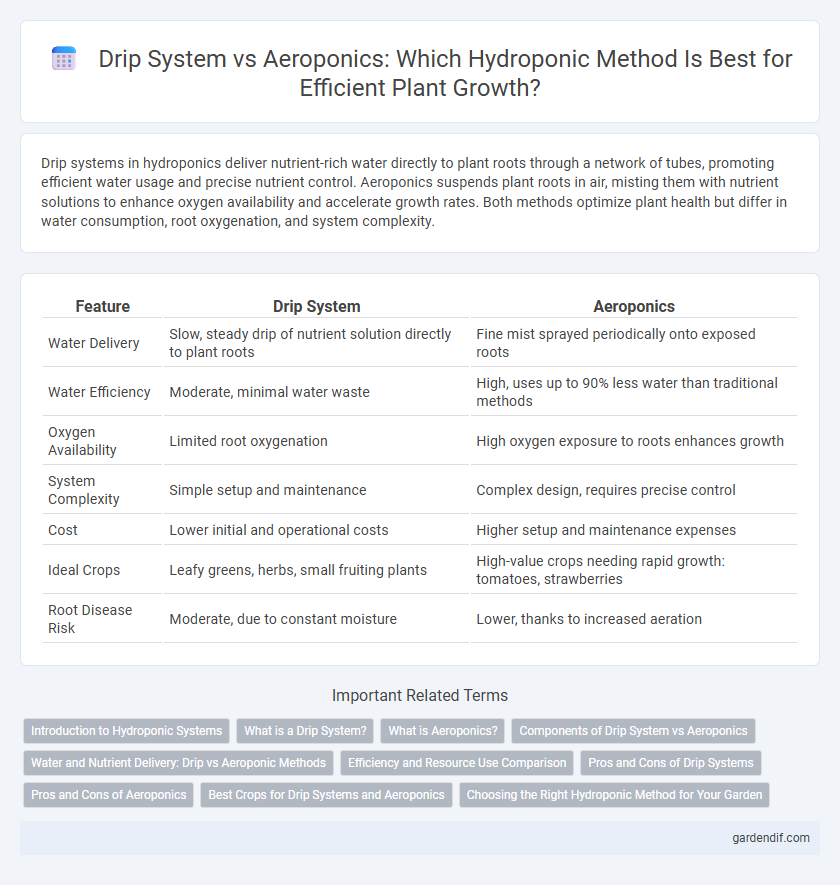
Drip System vs Aeroponics Illustration
Drip systems in hydroponics deliver nutrient-rich water directly to plant roots through a network of tubes, promoting efficient water usage and precise nutrient control. Aeroponics suspends plant roots in air, misting them with nutrient solutions to enhance oxygen availability and accelerate growth rates. Both methods optimize plant health but differ in water consumption, root oxygenation, and system complexity.
Table of Comparison
| Feature | Drip System | Aeroponics |
|---|---|---|
| Water Delivery | Slow, steady drip of nutrient solution directly to plant roots | Fine mist sprayed periodically onto exposed roots |
| Water Efficiency | Moderate, minimal water waste | High, uses up to 90% less water than traditional methods |
| Oxygen Availability | Limited root oxygenation | High oxygen exposure to roots enhances growth |
| System Complexity | Simple setup and maintenance | Complex design, requires precise control |
| Cost | Lower initial and operational costs | Higher setup and maintenance expenses |
| Ideal Crops | Leafy greens, herbs, small fruiting plants | High-value crops needing rapid growth: tomatoes, strawberries |
| Root Disease Risk | Moderate, due to constant moisture | Lower, thanks to increased aeration |
Introduction to Hydroponic Systems
Drip systems deliver nutrient-rich water directly to plant roots through a network of tubes, optimizing water use efficiency and promoting consistent growth. Aeroponics suspends plant roots in the air while misting them with nutrient solutions, enhancing oxygen availability for faster nutrient uptake and growth rates. Both hydroponic methods eliminate soil, reduce water consumption by up to 90%, and increase crop yields through precise environmental control.
What is a Drip System?
A drip system in hydroponics delivers nutrient-rich water directly to the plant roots through a network of tubes and emitters, ensuring precise water and nutrient control. This method reduces water waste and promotes consistent moisture levels, making it ideal for a wide variety of crops. The drip system's simplicity and scalability make it a popular choice for both commercial growers and home gardeners seeking efficient plant growth solutions.
What is Aeroponics?
Aeroponics is a soil-free cultivation method where plant roots are suspended in air and continuously misted with nutrient-rich water, optimizing oxygen exposure and nutrient absorption. This system enhances growth rates and resource efficiency compared to traditional drip systems that deliver nutrients directly to the root zone via tubing. Aeroponics offers precise control over environmental variables, leading to higher yields and reduced water usage in hydroponic farming.
Components of Drip System vs Aeroponics
The drip system in hydroponics consists of components such as emitters, tubing, a nutrient reservoir, and a pump to deliver nutrient solution directly to plant roots in controlled drops. Aeroponics uses a misting system with high-pressure pumps, nozzles, and a sealed chamber to suspend roots in air and spray nutrient-rich mist. Both systems rely on precise nutrient delivery but differ in their structural setups, with drip systems using soil or substrate beds and aeroponics suspending roots in air for increased oxygen exposure.
Water and Nutrient Delivery: Drip vs Aeroponic Methods
Drip systems deliver water and nutrients directly to the root zone through emitters, providing precise control over moisture levels and nutrient concentration, which reduces waste and prevents overwatering. Aeroponics suspends plant roots in air and periodically mists them with a nutrient-rich solution, enhancing oxygen availability and promoting faster nutrient absorption. Both methods optimize water efficiency, but aeroponics typically uses up to 90% less water than drip systems, making it ideal for resource-limited environments.
Efficiency and Resource Use Comparison
Drip systems deliver nutrient-rich water directly to the plant roots with high precision, offering excellent water use efficiency and minimal nutrient waste, making them ideal for scalable hydroponic setups. Aeroponics suspends roots in the air and mists them continuously, maximizing oxygen exposure and promoting faster growth rates, but typically requires more energy for misting mechanisms. In terms of resource use, drip systems generally consume less electricity, whereas aeroponics optimize plant growth speed and oxygen availability at the cost of increased energy demand.
Pros and Cons of Drip Systems
Drip systems in hydroponics offer precise water and nutrient delivery directly to plant roots, enhancing resource efficiency and reducing water waste compared to traditional methods. These systems are highly scalable, easy to manage, and cost-effective, but they can be prone to clogging issues that require regular maintenance to ensure optimal performance. The controlled environment of drip systems supports consistent plant growth, though aeroponics might provide faster growth rates due to its high oxygen availability at the root zone.
Pros and Cons of Aeroponics
Aeroponics offers superior oxygenation and nutrient delivery by suspending roots in a mist environment, resulting in faster plant growth and higher yields compared to drip systems. The system's water efficiency and reduced risk of root diseases make it ideal for controlled environments with limited resources. However, aeroponics requires precise maintenance and higher initial costs, with vulnerability to system failures that can quickly harm plant health.
Best Crops for Drip Systems and Aeroponics
Drip systems excel in growing leafy greens, tomatoes, and strawberries due to their precise water delivery and nutrient control, enhancing root-zone aeration and reducing water waste. Aeroponics is ideal for high-value crops like lettuce, herbs, and microgreens, as it provides maximum oxygen exposure to roots, accelerating growth and improving nutrient absorption. Both systems optimize crop yield but selecting the best depends on crop type and resource availability.
Choosing the Right Hydroponic Method for Your Garden
Drip systems deliver nutrient-rich water directly to plant roots with precise control, making them ideal for large-scale or soil-less gardens requiring efficient water use. Aeroponics suspends roots in air, misting them with nutrient solutions, enhancing oxygen delivery and accelerating growth but requiring more technical upkeep and higher initial investment. Selecting between drip systems and aeroponics depends on garden size, crop type, budget, and desired growth rate, emphasizing efficiency versus maintenance complexity.
Drip System vs Aeroponics Infographic

 gardendif.com
gardendif.com